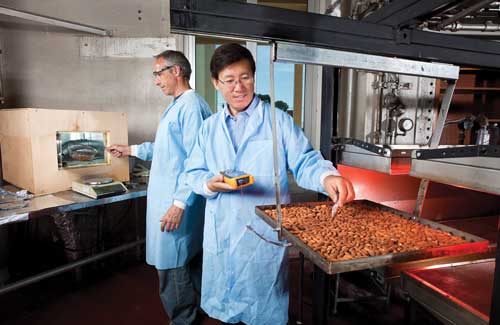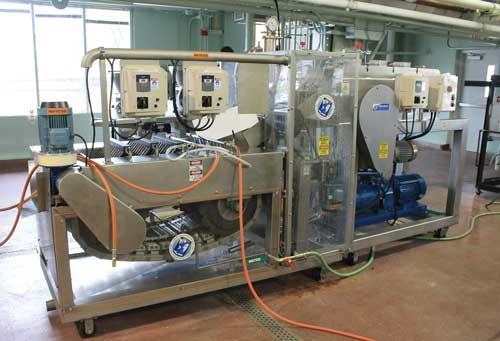Innovative Infrared Food Processing
PROCESSING
Bill Gates said, “Governments will always play a huge part in solving big problems. They set public policy and are uniquely able to provide the resources to make sure solutions reach everyone who needs them. They also fund basic research, which is a crucial component of innovation that improves life for everyone.”
 It is my privilege to share this month’s column with Zhongli Pan, an innovative leader in the development and application of infrared processing for foods. Pan is a research engineer at the U.S. Dept. of Agriculture, Agricultural Research Service, Healthy Processed Foods Research Unit in Albany, Calif., and an adjunct professor for the University of California, Davis, in the Dept. of Biological and Agricultural Engineering. His research on infrared (IR) processing of foods is a wonderful example of the role government research can play in providing innovative solutions to consumers and the food industry.
It is my privilege to share this month’s column with Zhongli Pan, an innovative leader in the development and application of infrared processing for foods. Pan is a research engineer at the U.S. Dept. of Agriculture, Agricultural Research Service, Healthy Processed Foods Research Unit in Albany, Calif., and an adjunct professor for the University of California, Davis, in the Dept. of Biological and Agricultural Engineering. His research on infrared (IR) processing of foods is a wonderful example of the role government research can play in providing innovative solutions to consumers and the food industry.
Principles of Infrared Heating
IR radiation releases energy in electromagnetic wave form in the spectrum from 0.75 μm to 1,000 μm. The wavelength of IR generally can be further classified into three ranges, namely, near-IR (0.75 μm to 1.4 μm), medium-IR (1.4 μm to 3 μm), and far-IR (3 μm to 1,000 μm). Principal food components, including water, organic compounds, and biological polymers, absorb IR radiant energy efficiently in the wavelength range of 2.5 μm to 10 μm through changes in molecular vibration states, which corresponds to the medium- and far-IR regions. Hence the medium- and far-IR radiation can be efficiently used for thermal processing of food and agricultural products.
The advantages of using IR for heating include no need for heating medium, high heat delivery rate, reduced usage of water and chemicals, improved energy and processing efficiency, reduced equipment footprint, and increased productivity, while at the same time delivering high quality and safe processed foods.
IR heating is most suitable for heating thin layers of food materials. The IR radiation does not penetrate deeply and heats only a few millimeters below the surface of foods. The absorbed energy can then be conducted to other areas within the food; however, as the sample volume increases, the conduction is limited.
Infrared Processing Equipment
Based on the energy source, two types of IR emitters are used in the food industry, namely electric IR emitters and gas-fired IR emitters. Electric IR emitters have a metal filament placed inside a sealed enclosure that is either evacuated or filled with inert gas. Radiant energy in these heaters is generated by passing electric current through high-resistance wire. The element and the material surrounding the element are heated to an incandescent temperature. By modulating the power output, the spectrum of wavelength of these electric IR emitters can be varied. The available types of electric IR radiant emitters include reflector-type incandescent lamp, quartz tube, and resistance elements. Advantages of electric IR emitters include ready availability, ease of control, instrumentation, and possibility for wide selection of heating elements. In addition, electric IR emitters generate zero emissions. However, electric-powered IR processing can be expensive due to the high cost of electricity.
Alternatively, different types of gas-fired IR emitters, including direct-flame IR radiator, ceramic burner, metal fiber burner, high-intensity porous burner, and catalytic burner, are available. Combustion of air and fuel takes place on the burner surface in gas emitters and that results in an increase in the surface temperature and emits radiation in the wavelength range of 1.6 μm to 10 μm. Natural gas or liquefied gas (propane) can be used for heating perforated ceramic surface or steel tubes that emit radiation. High-moisture substances can absorb more radiation emitted by this class of IR emitters. One advantage of the gas-fired IR emitters is that they are not dependent on electricity, and thus cheaper in terms of operating cost. They are also capable of saving energy and are more reliable and durable than electric IR emitters. However, the initial cost of a gas-fired IR emitter is higher than electric IR emitters. Operating gas-fired IR emitters with flame also requires thorough ventilation to reduce hazards of evolved carbon monoxide. Alternately, flameless catalytic gas-fired emitters are available; these release IR energy through exothermic catalytic chemical reactions of natural gas. With catalytic burners, natural gas combines with air across the platinum catalyst and reacts by oxidation-reduction to yield a controlled bandwidth of IR energy and small amounts of CO2 and water vapor.
--- PAGE BREAK ---
Applications of Infrared Heating to Food Processing
IR heating was first used industrially in the 1930s for automotive curing applications and rapidly became utilized in the manufacturing and the electronics industry. In the last two decades, due to significant progress in better understanding the mechanism of IR heating coupled with improvements in the design of IR emitters, IR processing applications in the food industry have been realized. The food industry currently uses IR for baking breads and baked goods, roasting nuts, and browning meats and other foods. Newer applications that are still under development include the following.
 • Infrared peeling. Hot lye peeling and steam peeling are the two techniques currently used by the fruit and vegetable processing industry. The wastewater from lye peeling and the low product quality of steam-peeled products are major concerns for the food industry. Because of the high heat delivery capability and low penetration depth, IR is a suitable heating method for loosening skin and peeling of fruits and vegetables. Since IR does not need a heating medium such as water for the delivery of energy to the product, the process was named as dry-peeling and a U.S. patent application was recently issued. The application of IR dry-caustic peeling was studied for white potatoes and peaches, and the results exhibited significant decreases in peeling loss, usage of caustic lye, and generation of wastewater. IR dry-peeling of tomatoes has been studied extensively from multiple aspects, including physical attributes of tomatoes from different cultivars, peeling performance, peeled product quality, and biomechanical and anatomical features of IR-peeled skins. Higher peelability and lower peeling loss have been obtained by IR dry-peeling compared to steam and lye peeling methods. Recently, a pilot IR dry-peeling system equipped with electrical IR emitters was successfully designed, built, and tested at two tomato processors, showing superior performance. This equipment is being further optimized, and the technology is being extended to other fruits and vegetables.
• Infrared peeling. Hot lye peeling and steam peeling are the two techniques currently used by the fruit and vegetable processing industry. The wastewater from lye peeling and the low product quality of steam-peeled products are major concerns for the food industry. Because of the high heat delivery capability and low penetration depth, IR is a suitable heating method for loosening skin and peeling of fruits and vegetables. Since IR does not need a heating medium such as water for the delivery of energy to the product, the process was named as dry-peeling and a U.S. patent application was recently issued. The application of IR dry-caustic peeling was studied for white potatoes and peaches, and the results exhibited significant decreases in peeling loss, usage of caustic lye, and generation of wastewater. IR dry-peeling of tomatoes has been studied extensively from multiple aspects, including physical attributes of tomatoes from different cultivars, peeling performance, peeled product quality, and biomechanical and anatomical features of IR-peeled skins. Higher peelability and lower peeling loss have been obtained by IR dry-peeling compared to steam and lye peeling methods. Recently, a pilot IR dry-peeling system equipped with electrical IR emitters was successfully designed, built, and tested at two tomato processors, showing superior performance. This equipment is being further optimized, and the technology is being extended to other fruits and vegetables. Although IR heating is not suitable for all food heating processes due to its limited penetration depth, it does offer significant advantages for processing foods in specific applications. It is anticipated that application of IR in food processing for surface heating applications will continue to grow during the years ahead. It is also anticipated that control of the IR spectrum employed when heating will be tailored to specific food processing needs in the future, providing selective heating and optimal response.
 Tara McHugh, Ph.D., Contributing Editor,
Tara McHugh, Ph.D., Contributing Editor,Research Leader, USDA Agricultural Research
Service, Albany, Calif.
[email protected]


